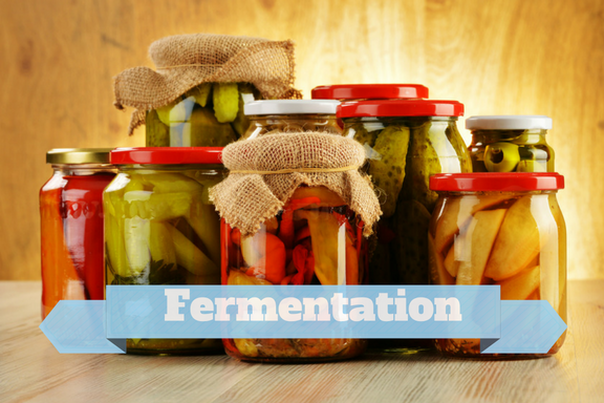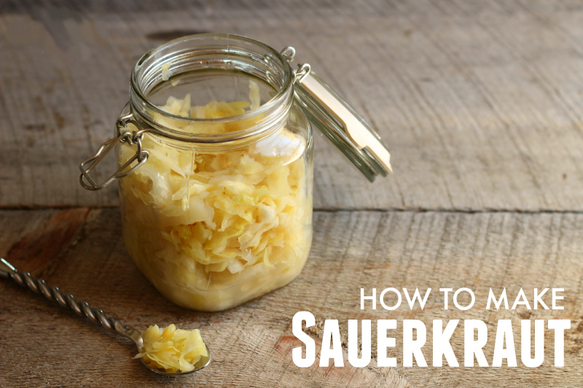Humans have been fermenting food since ancient times. But now, as dishes like kimchi, sauerkraut and kombucha have become seriously hip, science is discovering the stuff may be an elixir of healthWhat exactly is fermentation?Fermentation is the process of preserving and ennobling food by allowing bacteria to feast upon it. This process of benevolent decay is the same process that turns grapes to wine, hops to beer, soy beans to miso, cocoa beans to chocolate and milk to cheese. The key difference between fermentation and rot, is that fermentation is anaerobic, consuming no oxygen, while rot is aerobic. Leave a cabbage leaf in the open air and it will rot; submerge it in liquid and it will ferment. The amount of probiotics and enzymes available in the average diet has declined sharply over the last few decades as pasteurized milk has replaced raw, pasteurized yogurt has replaced homemade, vinegar based pickles and sauerkraut have replaced traditional lacto-fermented versions, the list goes on. The Science THE ADULT HUMAN BODY is home to around 3kg of bacteria – roughly the same weight as your brain. Every nook and cranny of your person is swarming with microscopic bugs, from your skin to your mouth to your throat to your gut. You are not an individual entity – you’re an ecosystem, home to vast, teeming populations of bacteria. And these bacterial populations, collectively known as microbiota, are crucial to your good health. We’re a composite organism and this microbial component is just as important to our biology as our human cells. So important is our microbiota, scientists are now beginning to think of it like an organ, just like your stomach, liver or kidneys. These microbial legions modulate our immune systems and control our metabolisms, they regulate our central nervous system and shape our moods. Although the precise mechanisms remain shadowy, the importance of these populations of bacteria are now scientific fact. Obesity, cancer, depression, allergies, cardiovascular disease, inflammatory bowel disease, autoimmune diseases like asthma, even tooth decay – are all being traced back to disruptions in our microbiota. Put simply, these vast populations of bacteria don’t live on or in us – they live with us. Without us they die; without them, we die. Our microbiotas start developing at birth. In our mother’s womb we are sterile, free of all bacteria. But as we begin struggling down the birth canal, then pushing our heads into the light, we are coated with millions of microbes. When we first take our mothers nipple and begin sucking down breastmilk, we ingest millions more (breast milk is swarming with the good stuff). And thus the process begins, a process that gathers steam as we begin eating, crawling, walking. By the time we’re three, our microbiotas have been largely established. Whether your bacterial ecosystem is diverse and healthy or narrow and fragile depends (to a large extent) on those first 3 years of life. If you were born by caesarean section, then your microbiota would have suffered. If you were fed formula rather than breast milk, it would have suffered further. If you led a cocooned existence as a child, rarely getting dirty or touching other humans or patting animals, it would have taken another hit. If this describes your early life, don’t despair. Over the past few decades, the entire Western world has been doing its level best to destroy our bacterial friends. We’ve been starving them with low-fibre diets, ravaging them with antimicrobial soaps, obliterating them with course after course of antibiotics. We’ve sought to cleanse them from our kitchens, scrub them from our skin, poison them from our guts. Little surprise that, taken as whole, our microbiotas are seriously impoverished. Like a rainforest that has been burned and logged, our bodies have become inhospitable places of our bacteria. The Nutrition Fortunately, the great strength of the microbiota is its malleability. Fragile microbiota can be strengthened, just as robust ones can be weakened. AND this is where fermented foods come in! These foods teeming with colonies of bacteria are an antidote to out sterile modern landscape of antimicrobial soaps and antibiotic medications; they are the handfuls of live seeds spread over that burned and logged rainforest. There’s good evidence that taking live microbes orally has a real impact on our health. The data is not yet overwhelming, but its pointing in the right direction. Fermentation transforms foods nutritionally. The pre-digestion of fermented foods makes the nutrients more easily available to us. Fermentation also causes the production of certain unique micro-nutrients that are produced by the bacteria as they ferment the food. Then there are the strains of live bacteria that are found only in certain types of fermented food. To have a food that can improve your immune function and mental health – that’s huge. Sure, stuffing vegetables in jars and letting bacteria do their thing may be well and good in a backwoods retreat or the world’s finest chef in their gleaming kitchens. But what about the rest of us? Should we really be packing cabbage into jars and waiting till the bugs have their way? Can’t we just buy a bottle of Yakult? Ah well no. Yakult’s just good marketing and is actually really high in sugar. Pickled vegetables are similarly dismissed as they are preserved in vinegar which kills off bacteria. Jars of sauerkraut are also not ideal as to ensure they don’t “explode on the shelf”, they have been pasteurised, eradicating most of the good bacteria. The best (and cheapest) method is to make your own! Humans didn’t invent fermentation; fermentation created us. Hone your fermenting skills with this basic sauerkraut recipe Ingredients
Process
Enjoy! 7d6fbfef34fbff4e3e1119afe71fbc5ba1e3ff8512183cd0e5
1 Comment
28/8/2018 09:38:52 pm
Colon Hydrotherapy has been proven to be effective in timers f cleaning our colon and other benefits we can get from it. I am happy to know that it's now being offered in Brighton and people can actually avail the said service. There's just one thing I hope about this therapy. I am hoping that it's being offered on a affordable and reasonable price so that more patients can have it as their treatment. All patients deserves to be cured, isn't it?
Reply
Leave a Reply. |
Archives |
|
Location
119 Shakespeare Road, Milford / Takapuna North Shore, Auckland |
Hours
Monday: 7am - 6pm Tuesday: 10am - 6pm Wednesday: Closed Thursday: 1.30pm - 8pm Friday: 7am - 1pm Saturday: 9am - 12pm Affiliations |
Proudly powered by Weebly



 RSS Feed
RSS Feed


